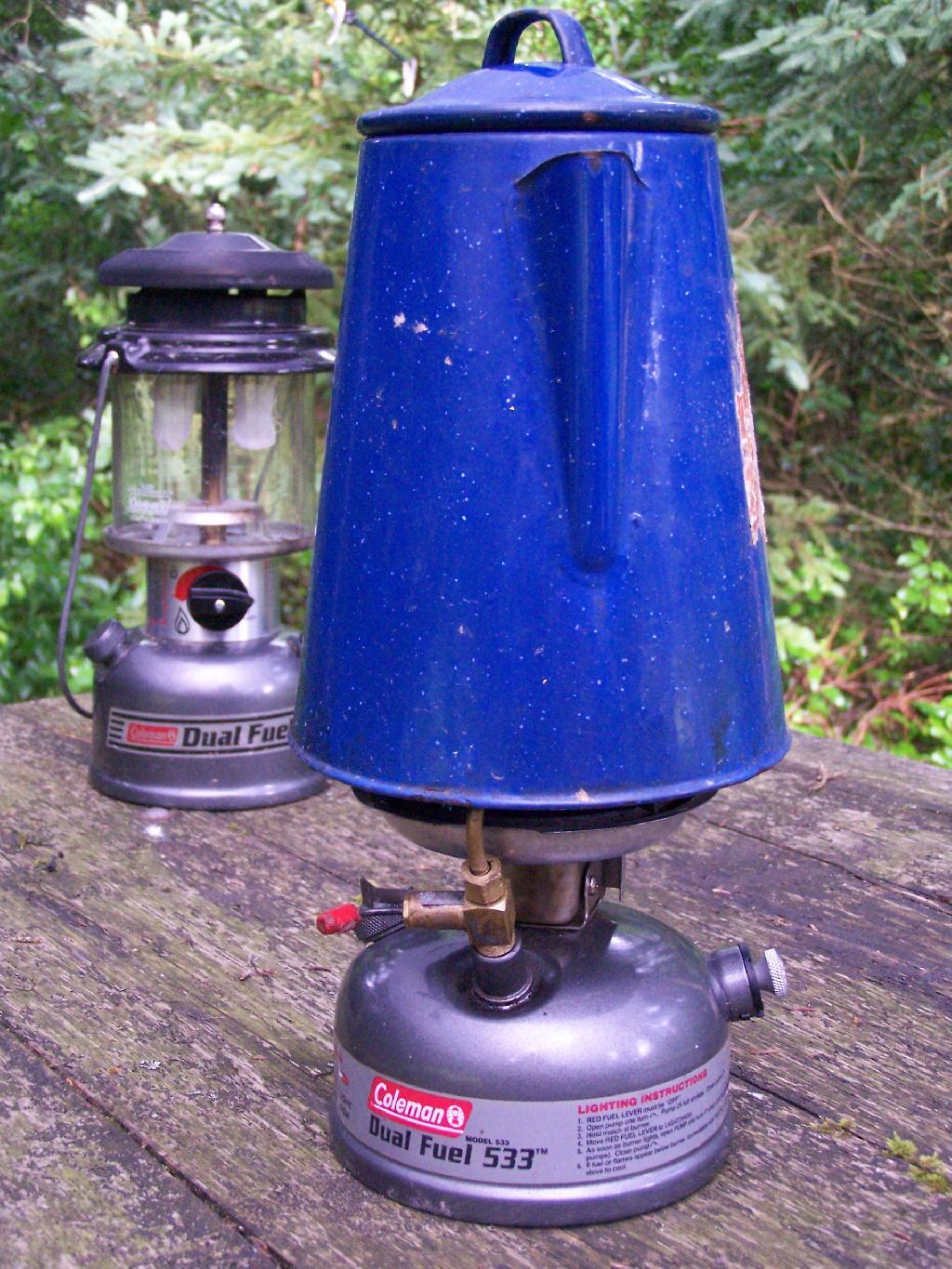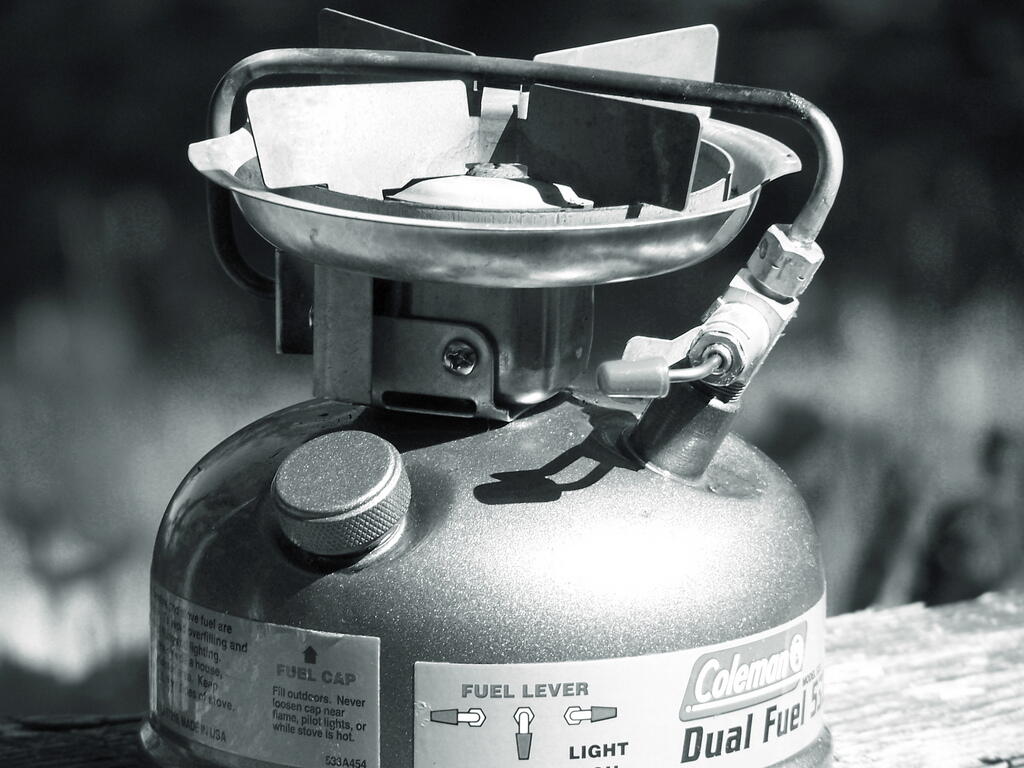Coleman Fuel or Gasoline in Dual Fuel Stoves
I have a dual fuel stove and a dual fuel lantern, that can burn either regular automobile gasoline, or Coleman Fuel aka white gas. Being that I spend a lot of time camping, and being that I’m cheap, and thought it was stupid to be buying Coleman Fuel in aluminum containers that ultimately just get discarded in the recycle bin, I figured I would just run the stove and lantern on gasoline.
The problem with gasoline is that contains larger hydrocarbons and more aromatic hydrocarbons then Coleman Fuel. Gasoline is a heavier hydrocarbon, although with the addition of aromatic hydrocarbons allows it be burned in relatively low compression gasoline engines, and not knock when climbing steep hills or other times of heavy load on engines.
Gasoline clogs up dual stoves and lanterns, especially if it’s allowed to sit in the stove, and degrade. It creates a film on the edge of gas tanks, and even worst, forms a film along the edge of the “generator” tube, that when heated, vaporizes the fuel and turns it into a gas, so that stove or lantern can burn it to make heat or light without the use constantly pumping the stove. I ended up having to saturate a generator for the stove with carburetor cleaner, and actually replacing one, due to the use of gasoline plugging it up.
Gasoline also smells, both when you fuel the stove or lantern, and when you burn it. It’s okay when the stove is running at full temperature, and generator is working fine, fully vaporizing the fuel prior to combustion, but if you turn down the stove, or the generator starts to become clogged, you’ll smell the aromatic hydrocarbons and even the sulfur in the gasoline.
After burning pure gasoline in a dual fuel appliance, you’ll want burn only Coleman Fuel. Coleman Fuel burns hotter, and generally better. It does not plug the “generator” tube, it does not nearly smell as bad. It works so much better. Yet, it’s expensive. The first can of Coleman Fuel I bought three years ago was $4.50, then it was $6.60 in 2008, an era of $4.25 gasoline, and now it’s up to an insane $8.80. I use a lot of fuel as I camp a lot, but rarely go through more then a gallon can a year.
I have found Gasoline can be used in a dual fuel appliance, reliably, if it is blended at a rate of 50-50. I’ve had pretty good luck with such a mixture, because the Coleman Fuel seems to dissolve the gasoline residue, and makes gasoline burn hot enough that it does not smell. During the end of camping season, I’ll only use Coleman Fuel, to make sure all the gasoline deposits are dissolved, and it won’t clog the generator up when it sits over the winter.


14 Comments
Thanks for the info. I have a dual fuel but have not used gas. It just makes me nervous! The points of it burning dirtier, using Coleman fuel to clean, and the 50% mix, all make sense.
I have only used gas station gas in my Coleman stoves and lanterns since I bought my first used one in 1988. I have bought a one gallon can of Coleman fuel, but I never opened it. Cooking on that stove right now as I type. I heat my house with it too.
I have been running regular unleaded gasoline In my 424 dual fuel stove for almost 3 years now, with a twist, so to speak. I am an rv/camper and use this stove daily. I add Stabile Ethanol Fuel Treatment (one ounce per gallon) to the gas more so to keep the generator clean although it does keep the gas fresh longer as well. About every 10 tanks or so of gasoline used, I then switch to coleman (white gas) fuel for a tank or 2 which blows out any build up quite nicely. This stove has 3 years of extensive daily use and I have not needed to clean or replace anything. Works great! Hope this info helps. Side note: I normally swear by Sea Foam fuel additive for autos and for preserving fuel, but for some reason it does not work as well in stoves and lanterns. Just my experience.
That’s really interesting. I usually try to alternate between Coleman Fuel and gasoline, but I don’t like to leave gasoline in the stove or lantern if I can avoid it. I will have to try using Stable Ethanol Fuel Treatment, to see if I can use more gasoline in the stove, as Coleman Fuel has gotten to be like $13 a bottle — and I use a couple of gallons a year, on top of gasoline usage.
Been thinking of trying E85 in my stoves and lanterns, anyone ever try it and if so how well does it work?
I’ve not used E-85 but regular gasoline tends to clog the generator tubes over time, especially if you don’t mix with Coleman Fuel. I don’t think E85 would be as much of a problem for clogging, but it might eat away over time as the pump seals (which are cheap to replace).
I put a touch of carb cleaner in the gas I use on my duel fuel lanterns and stoves. All were purchased in 1984 when I was a Boy Scout. I have never had to rebuild repair or replace anything but mantels and I still camp 30-45 days a year.
When you say a touch, how much carb cleaner are you referring to. I’ve begun using dual fuel stoves and intend to use gasoline due to the price of Coleman fuel these days. I recently made Eagle and intend to help out around the local troop with trips, and will be making a decent number of trips every year. It would be very helpful to start using this method, considering you’ve basically got it down to perfection after all this time!!
I live in Texas. Murphy USA and a few other locations have ethanol free gasoline. Aviation gas is also ethanol free. I haven’t used any in my dual fuel stove however I’ve been using using it in all my small engines. Have never since experienced any gumming issues, surging, starting, or other problems. Locally non ethanol gas is about $4 per gallon 2/1/2022
Hey,
here in Germany you can buy alkylite petrol in hardware stores. It is used for lawn mowers and small engines in chain saws etc. It burns clean and „more healthy“ so you won’t be exposed to toxic exhaust gases.
It is perfect for the use in coleman stoves. 5 liters (1.3 gal) cost 20ish €
Markus
Cool nice to know
I own a Coleman Dual Fuel 533, and I’m seeking information regarding fuel. The Coleman Brand was $18 for a gallon at the local ACE Hardware in South West Florida. That’s just ridiculous! I have access to Ethanol Free Fuel (Recreation Gas) as well Top-Tier, High Octane fuels such as Sunoco Ultra 93…currently just under $5 a gallon. I’m also very interested if anyone can offer an opinion on Crown (white gas) vs. Coleman (brand name white gas). The Crown Gas costs less, is it also less quality? And the Carb Cleaner or fuel Stabilizer idea, I have no experience with.
It seems the worst case scenario is a clogged stove requiring take-down, cleaning, and possibly a spare parts kit. What makes a Dual Stove capable of burning gasoline while most stoves require white gas? Any suggestions on a bag or container for the stove? I tried a Folgers Coffee Container and the 533 fits inside, kind of.
As an Eagle Scout (1986) and two treks at Philmont, I’m familiar with stoves and campfires. I think the Coleman 533 is the Main Battle Tank of stoves. We used Coleman white gas stoves at Philmont (heavy but highly reliable) both treks. Just looking for any wisdom in an age where “fossil fuels” are going the way of the dinosaur. What to do? How about Lithium Battery Powered Stoves…
ummm…no, I don’t think so, not for me!
-Be Prepared
I found one of these and would like to try what I have which is 70% isopropryl alcohol or denatured alcohol. Could I try it with one of these just to see if it works?
Alcohol does not work. Just use some non ethanol gas. Put some oil in the little oil hole on pump and see if it pumps. Fuel cap may leak or hiss when you pump tank up. Sometimes a drop of oil on rubber seal in fuel cap will soften it enough to seal off. Pump may need attention if not pumping after you oil it. Sometimes the rubber piston is cracked. Leather ones never crack, at least none of mine have. Cooking on an old one right now.